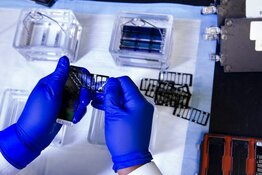The Life Sciences Report: Can you tell me a little bit about your role as an analyst at your firm?
Jeff Cohen: Ladenburg Thalmann is a public company, and the firm has a retail and advisory network that manages approximately $75–80 billion ($75–80B) in client assets. The firm's institutional division has about 15 analysts covering approximately 200 companies. Four analysts are focused on the healthcare sector. I cover micro-, small- and mid-cap medtech and healthcare companies. Each analyst has some level of autonomy in deciding what companies to cover.
TLSR: How do you choose companies for your coverage list?
JC: I search for medical technology companies developing innovative therapies, primarily within the endovascular and cardiovascular space, for the brain, for the skeletal system and in the regenerative space—which includes both harvested and cellular engineered products and tissue forms. I am particularly interested in companies looking to improve patient interventions and long-term outcomes while producing an economic benefit to the entire cascade of payers in the healthcare system.
TLSR: What do you mean by cascade of payers?
JC: Cascade of payers refers to the sources of revenue: the hospitals, the deductibles that patients themselves pay and the private and public insurance companies. I analyze the ease or difficulty with which the use or purchase of a new product is likely to be reimbursed by institutions and insurance firms. Most insurance companies try to determine a time versus cost benefit for adopting a new therapy over the current standard of care—whether that is a savings in paying for hospitalization, operation time, or time for recovery.
TLSR: Are you looking mainly at products that aim to make incremental improvements to existing medical delivery systems, or toward innovations that will jump-start major changes?
JC: Improvements in medicine are generally incremental—however, some come in much larger increments than others. A slight incremental change may have a hard time getting reimbursed in the insurance system. But a large incremental change will make it easier for that product to obtain regulatory approval and to garner buy-ins from physicians.
TLSR: What qualities do you look for in a management team?
JC: I favor senior management teams that develop a strategic five-year vision for each product in their pipelines. I like management teams who are less focused on telling the Street what is possible and what they can do, and are more focused on actually doing. Don't tell me, show me!
"I prefer to find companies that are unknown or undiscovered, underappreciated or misunderstood."
I do understand that there are competitive issues and that some companies only want to disclose a certain amount of information about their respective businesses. However, managers must provide as much information as possible so that analysts can grasp the comparative advantages of a new product.
TLSR: How do you assess the relative merits of junior firms as compared to more established companies?
JC: I follow smaller-cap companies, which are not the dominant forces within their respective industries or markets. My companies tend to be at the forefront of innovation, creating products that larger entities may wish to own. The smaller players often possess the entrepreneurial spirit necessary to succeed in competition with stronger forces. The market caps of my companies are typically between $20 million ($20M) and $1 billion ($1B).
TLSR: Are these companies able to access capital when they need it?
JC: Most companies with a clear path to commercialization—or current commercialization— are able to gain access to capital markets, mostly for capital for growth.
TLSR: Capital for growth based upon some degree of success already?
JC: Yes, based on whether the product is already approved, already selling or is close to an approval.
TLSR: Do you have some picks for us among the companies that you cover?
JC: Robotics is becoming increasingly important to the healthcare industry, and I currently cover Hansen Medical Inc. (HNSN:NASDAQ) and Mazor Robotics Ltd. (MZOR.NASDAQ).
"The smaller players often possess the entrepreneurial spirit necessary to succeed in competition with stronger forces."
Since 2007, Hansen has shipped approximately 110 Sensei robotic catheter units, which use electrophysiology to treat atrial fibrillation; the robot manipulates a catheter into the heart chamber. Last year the company introduced the Magellan endovascular robotic system, for use in interventions throughout the vast majority of blood vessels within the peripheral system. While we believe the new Magellan system offers many benefits, its adoption has been far slower than we had anticipated. About 10 clinical units have shipped: Four of those sold and one was leased for the balance of 2013.
TLSR: How has Hansen's stock been performing?
JC: We currently have a Neutral rating on Hansen. The stock is at about $1.65, relatively unchanged from a year ago.
TLSR: Tell me about Mazor Robotics.
JC: Mazor has its Renaissance robotic spine surgery platform, which enables surgeons to accurately insert pedicle screws and various other spinal implants and instrumentation in an extremely accurate fashion, with no reported cases of nerve damage. The unit consists of a cart that contains a central processing unit with software, screens and a small robot that can be affixed to the spine. The software package enables the robot to manipulate itself and show the physician exactly where to place the pedicle screws.
We anticipate that the company will soon offer an additional software package—as a bolt-on to the current system—that will enable biopsies and lead placements for the brain.
TLSR: How lucrative is the spine intervention market?
JC: Spine intervention is a huge market. There are more than 1M spine interventions in the U.S. annually. About one-third of those are appropriate for the Renaissance platform. The platform offers reduced radiation and procedure time, and superior accuracy reduces the rate of revisions while offering increased safety and a return on investment for hospitals and surgical centers. Mazor has placed 54 units worldwide, 28 of those in the U.S. The vast majority of growth has occurred since the device's U.S. introduction in late 2010.
TLSR: How much does the Renaissance robot cost?
JC: The U.S. cost of the unit is about $750,000 ($750K). Outside the U.S., it is approximately $500–550K, and that is a result of distribution agreements that Mazor has in place. The average selling price for the disposable kits used for each procedure ranges from $1–1.5K, depending on geography, with cost in the U.S. being more than in Europe or the rest of the world.
"I favor senior management teams that develop a strategic five-year vision for each product in their pipelines."
We estimate that by the end of 2014, there will be approximately 106 units placed worldwide, largely driven by acquisitions in the U.S. We expect that revenues over the next three years—2013, 2014 and 2015—will be $23.8M, $34.1M and $46.2M respectively, representing annual revenue growth of 96%, 43% and 36% year over year. Although the stock price and market cap have appreciated about 720% and 1,150% respectively since we initiated on Mazor in February 2012, it is still a timely investment with lots of upside built in. We rate the stock a Buy, with a $16.54 price target for the U.S. ADR listing.
TLSR: How do you pick target prices for the companies that you cover?
JC: I look at comparable companies in a similar sector or with a similar type of profile, whether in specific products or as a growth trajectory. I look at revenue multiples, earnings per share multiples, enterprise value to revenue multiples or price to sales ratios. In some cases, I use more than one metric to average a target price.
TLSR: When you are evaluating a company, how important is momentum in revenue and stock price movement?
JC: It is important, although I prefer to find companies that are unknown or undiscovered, underappreciated or misunderstood—or not over-followed by the Street.
TLSR: Can you give us some examples?
JC: CryoLife Inc. (CRY:NYSE) was founded more than 30 years ago to sell vascular and cardiac tissue, which it still sells, although it has expanded into a number of medical products, including hemostatic agents. We like Cryolife due to its potential growth trajectory. Its PerClot product is really well positioned. It is a hemostatic agent used during surgical interventions to absorb blood. The product is currently approved and bringing in around $5M annually in a few geographies outside the U.S. PerClot is approved to begin a U.S. clinical trial, which is anticipated to be completed in 2015. We are very excited about it: The size of the U.S. market for hemostatic agents is about $900M, and worldwide the market is about $1.4B.
In mid-August Medafor Inc., a small, privately held company selling $45M worth of hemostatic agents annually, agreed to be purchased by C.R. Bard Inc. (BCR:NYSE) for more than $200M, plus up to $80M based upon sales milestones. Cryolife owns more than 8% of Medafor, dating back to a 2010 selling arrangement, which should bring in a gain of $14.2M to Cryolife. Plus, Cryolife will be eligible for $6.71M for future sales milestones.
"I search for medical technology companies developing innovative therapies, primarily within the endovascular and cardiovascular space, for the brain, for the skeletal system and in the regenerative space."
AxoGen Inc. (AXGN:NASDAQ), has emerged as a player in the regenerative space, selling a nerve allograft aimed at replacing the current standard of care, known as autografts, in which a surgeon harvests a nerve from the back of a patient's leg and then grafts it into place elsewhere. AxoGen uses fresh nerves from cadavers, so no harvesting of the patient's nerves is needed. AxoGen was previously a private company located in the research park at the University of Florida in Gainesville. It merged with a public company called LecTec Corp in 2011. LecTec was basically defunct but had cash on its balance sheet that it wanted to put to work. Bingo.
OvaScience (OVAS:NASDAQ) has been public for less than a year, and is backed by a tremendous amount of science and clinical studies. It aims to improve the quality of human eggs, thereby increasing rates of success for in vitro fertilization (IVF). That is a huge market. There are more than 1.4M IVF cycles performed annually, of which only 160K are performed in the U.S.
We previously expected the company would launch and commercialize its Augment IVF product in the U.S. during 2014, but the company recently ceased development of that product in the U.S. to seek further FDA clarity regarding the specific development regulatory classification (tissue versus biologic).
OvaScience's financial model could take off if its current studies show higher rates of fertilization. In the U.S., the average cost per cycle is $14–16K. Outside the U.S., the IVF cycle cost is approximately one-quarter to one-half of that.
TLSR: Why do these products cost less outside of the U.S.?
JC: Pricing for medical technology in European markets and the rest of the world is often one-half to two-thirds the cost of the U.S., because medicine there tends to be socialized.
TLSR: How does U.S. Food and Drug Administration (FDA) regulatory approval impact these types of companies when they go abroad?
JC: Products with FDA approval are typically able to garner additional approvals swiftly in Europe. But companies with non-U.S. approvals often have to go through a rigorous procedure with the FDA when they seek to move their products in the other direction. Japan and China each have their own medical technology approval processes, which are data driven, very time-consuming and quite different from the U.S. regulatory system.
TLSR: Any other names?
JC: Tribute Pharmaceuticals Canada Inc. (TBUFF:OTCQB) is a small, Canada-focused specialty pharmaceutical company. It sells eight products in Canada and a couple of products internationally. Tribute sells its Cambia brand, for acute migraine, in Canada. The medication is sold in a sachet form, a powder mixed with a couple of ounces of water. It is extremely fast acting. Nautilus Neurosciences Inc. (private) has licensed Cambia to Tribute for sale in the U.S., where revenues from the product are estimated to be $35M annually.
Another Tribute product is called Bezalip SR (bezafibrate), which is a fibrate drug intended to lower cholesterol. Tribute acquired a license two years ago to sell the drug in Canada. The company also owns the license to sell Bezalip in the U.S. The company expects that it will file an investigational new drug (IND) application in the U.S. by the end of the year. The size of this market is approximately $17B in the U.S, of which the fibrate portion is approximately $4.5B.
TLSR: Thanks for your time, Jeff.
JC: My pleasure, Peter.
Jeffrey Cohen, director, equity research with Ladenburg Thalmann & Co. Inc., has more than 20 years of professional experience in the worldwide financial markets, working with such companies as Cantor Fitzgerald, the American Stock Exchange (NYSE Euronext) and Sanwa Bank. For the past 13 years, Cohen has been actively involved in direct research, analysis and marketing pertaining to the growing $2.7 trillion U.S. healthcare sector, including detailed fundamental and financial analysis specific to the development, marketing, delivery and commercialization of medical technologies, therapeutics and various other healthcare solutions. During the past seven years, Cohen has developed, published and presented detailed fundamental analytical reports and financial models for more than 34 publicly traded and privately held medical technology, healthcare service and biotechnology companies with more than $14B in aggregate market capitalization. Cohen is an engineer by early training and education (he holds a bachelor's degree in engineering from the University of Pennsylvania), and has several years of experience planning, designing and implementing complex fixed-rail automated transportation systems. He also holds a master's degree in business administration and various FINRA licenses.
Want to read more Life Sciences Report interviews like this? Sign up for our free e-newsletter, and you'll learn when new articles have been published. To see a list of recent interviews with industry analysts and commentators, visit our Streetwise Interviews page.
DISCLOSURE:
1) Peter Byrne conducted this interview for The Life Sciences Report and provides services to The Life Sciences Report as an independent contractor. He or his family own shares of the following companies mentioned in this interview: None.
2) The following companies mentioned in the interview are sponsors of The Life Sciences Report: None. Streetwise Reports does not accept stock in exchange for its services or as sponsorship payment.
3) Jeff Cohen: I or my family own shares of the following companies mentioned in this interview: None. I personally am or my family is paid by the following companies mentioned in this interview: None. I was not paid by Streetwise Reports for participating in this interview. Comments and opinions expressed are my own comments and opinions. I had the opportunity to review the interview for accuracy as of the date of the interview and am responsible for the content of the interview.
4) Ladenburg Thalmann & Co. Inc. discloses the following:
Hansen Medical Inc.: Ladenburg Thalmann & Co. Inc. makes a market in the subject company. Ladenburg Thalmann & Co. Inc. has not had an investment banking relationship with nor received compensation related to investment banking services from the subject company in the last 12 months.
Mazor Robotics Ltd.: Ladenburg Thalmann & Co. Inc. makes a market in Mazor Robotics Ltd. (MZOR). Ladenburg Thalmann & Co. Inc. had an investment banking relationship (advisory) with the subject company in the last 12 months. Ladenburg Thalmann & Co. Inc. received investment banking related compensation from the subject company in the last 12 months. Ladenburg Thalmann & Co. Inc. expects to receive or intends to seek investment banking related compensation from the subject company in the next 3 months.
Cryolife Inc.: Ladenburg Thalmann & Co. Inc. does not make a market in the subject company. Ladenburg Thalmann & Co. Inc. has not had an investment banking relationship with nor received compensation related to investment banking services from the subject company in the last 12 months.
AxoGen Inc.: Ladenburg Thalmann & Co. Inc. makes a market in AxoGen Inc. (AXGN). Ladenburg Thalmann had an investment banking relationship with AxoGen Inc. in the last 12 months. Ladenburg Thalmann & Co. Inc. acted as co-manager in a securities offering for AxoGen Inc. and received compensation related to investment banking services from AxoGen Inc. in the last 12 months. Ladenburg Thalmann & Co. Inc. expects to receive investment banking related compensation from AxoGen Inc. in the next 3 months.
OvaScience: Ladenburg Thalmann & Co. Inc. makes a market in the subject company. Ladenburg Thalmann & Co. Inc. had an investment banking relationship with OvaScience (OVAS) and received investment banking related compensation from OvaScience in the last 12 months. Ladenburg Thalmann & Co. Inc. acted as a co-placement agent in a securities offering for OvaScience in the last 12 months.
Tribute Pharmaceuticals Canada Inc.: Ladenburg Thalmann & Co. Inc. makes a market in the subject company. Ladenburg Thalmann & Co. Inc. had an investment banking relationship (placement agent in PIPE) with Tribute Pharmaceuticals Canada Inc. (TBUFF) and received compensation (including warrants) related to investment banking services from the subject company in the last 12 months. Tribute Pharmaceuticals Canada Inc. and Teva Pharmaceuticals Industries (TEVA‐Not Rated) have joint development interests. The chairman of Teva also serves as chairman of Ladenburg Thalmann Financial Services, the parent company of Ladenburg Thalmann & Co. Inc.
5) Interviews are edited for clarity. Streetwise Reports does not make editorial comments or change experts' statements without their consent.
6) The interview does not constitute investment advice. Each reader is encouraged to consult with his or her individual financial professional and any action a reader takes as a result of information presented here is his or her own responsibility. By opening this page, each reader accepts and agrees to Streetwise Reports' terms of use and full legal disclaimer.
7) From time to time, Streetwise Reports LLC and its directors, officers, employees or members of their families, as well as persons interviewed for articles and interviews on the site, may have a long or short position in securities mentioned and may make purchases and/or sales of those securities in the open market or otherwise.











































